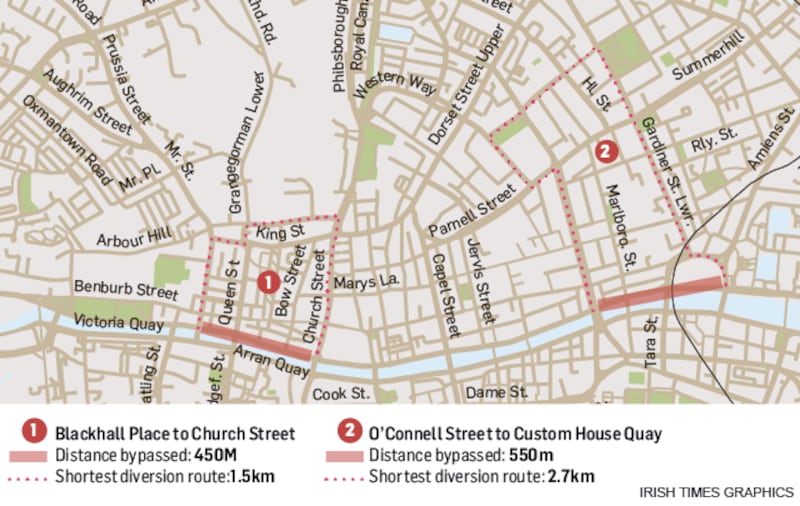Business organisation Dublin Town has questioned the legality of city council management deciding to ban cars from parts of the Liffey quays.
To accommodate the new Luas Cross City line, cars travelling east along the Liffey will be required to turn left on to O’Connell Street from Bachelors Walk. Cars will not be permitted to continue straight on to Eden Quay, which will be restricted to public transport including taxis, and will also be prohibited from turning right on to O’Connell Bridge.
The changes need to be in place ahead of the start of a trial run of the new Luas next August, the council said. It plans to implement the changes using its powers under the Road Traffic Act, rather than seek permission for the change from councillors or An Bord Pleanála.

Several councillors, including Lord Mayor Brendan Carr, have raised concerns about the proposal.
Dublin Town, an initiative involving city centre business owners and others, said in a submission to the council that it had obtained a legal opinion which indicated the traffic changes must have the approval of councillors before they could be introduced.
It said changes must not be considered in isolation from other major traffic projects in the city, such as the pedestrian and cycle plaza at College Green and the Liffey cycle route, and should be submitted for decision by An Bord Pleanála.
If the changes were sent to the planning board for adjudication, it is unlikely a decision would be made by August.
The council is submitting its College Green plans to An Bord Pleanála, while councillors will determine if the Liffey cycle route goes ahead.
Dublin Town said the changes on the quays had implications for a wider area than Eden Quay “as removing private traffic from this portion of the quays gives rise to diverted traffic in a number of other locations and these diversions need to be fully considered.”
Shortest diversion
For motorists forced to turn left on to O’Connell Street, the shortest diversion route to return to the riverside at Custom House Quay would be 2.7km. The same journey can currently be made in 550m.
A report commissioned by the council found the changes did not require an Environmental Impact Assessment (EIA) which would then have to be referred to An Bord Pleanála.
Dublin Town said its legal advice suggested that it “could be unsafe for Dublin City Council” to rely on this advice. It added that the council “may be accused of project-splitting” by not considering the traffic management changes in their entirety, to avoid the requirement to undertake the EIA.
Independent councillor Nial Ring said the changes were part of an “anti-motorist plan” for the city.
“The proposals are, to my mind, ill-thought out and potentially extremely damaging to the economy of the entire city centre of Dublin.”
Mr Carr last week said he could not support the current proposals for a new cycle lane on the north quays, because it would divert traffic through residential areas. He also said all the traffic management measures for the city centre should be considered in their entirety.
The council said it had introduced previous traffic measures for the Luas around Kildare Street and Dawson Street without seeking approval of councillors.















